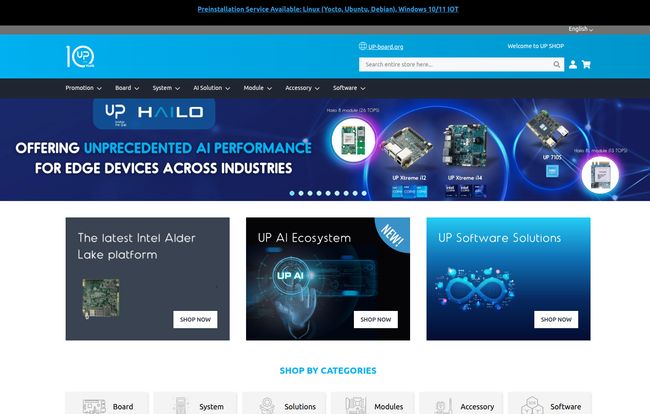Alright, let’s have a real chat. If you’ve spent any time in the maker space or dabbling in IoT, you’ve probably got a drawer full of Raspberry Pis. I know I do. They’re fantastic for learning, for home projects, for that retro gaming console you swore you’d finish building. But what happens when your project needs to grow up? When it needs to leave the house, get a real job in a factory, and handle some serious industrial-strength tasks?
That’s where things get tricky. You need more power, more reliability, and an architecture that plays nice with enterprise software. For years, this meant a huge leap in complexity and cost. But I've been spending some time with the offerings from a company called UP Bridge the Gap, and I’ve got to say, I'm pretty impressed. They seem to be hitting that sweet spot between DIY flexibility and industrial-grade brawn. It’s like your Raspberry Pi went to the gym, got a business degree, and is now ready for the boardroom.
So, What's the Deal with UP Bridge the Gap?
In a nutshell, UP Bridge the Gap is the public-facing shop for AAEON, a major player in the industrial PC world. They specialize in high-performance, x86-based single-board computers (SBCs). Think of them as compact, powerful PCs on a single board, designed for developers, engineers, and businesses who are building the next generation of AI and automation tools.
Their whole mission, as the name implies, is to bridge that chasm between the maker community and the demanding world of industrial applications. They’ve partnered with giants like Intel, Microsoft, and Amazon, which should tell you they’re not just messing around. This isn’t just a hobbyist shop; it’s a serious resource for professional-grade hardware.

Visit UP Bridge the Gap - UP Shop
A Look at the UP Board Product Family
Scrolling through the UP Shop is a bit like being a kid in a candy store, if the candy were powerful computing modules. You’ve got a whole range of options, from the more compact boards to full-fledged systems. Some of the headliners I've seen are the UP 7000 Series and the various UP Squared models. These aren't just minor upgrades from each other; they offer different levels of processing power, I/O ports, and form factors to fit different needs.
Who is this for? It’s for the engineer designing a machine vision system for a production line. It's for the startup building a custom AI-powered security camera. It's for the robotics enthusiast who needs more processing power than a typical ARM-based board can offer. The use of Intel processors (like the Alder Lake series in some newer models) means you can run full-fat versions of Windows 10/11 IoT or various Linux distros like Ubuntu and Yocto, which is a massive deal for compatibility with existing software.
The Good, The Gritty, and The Growing Pains
No platform is perfect, right? After spending time on their site and digging through forums, here’s my honest take on the highs and lows.
What I'm Genuinely Excited About
First off, the community support is a huge plus. When you're working with this level of hardware, you’re going to have questions. Having a community of fellow developers to bounce ideas off of is invaluable. It’s a safety net that can save you hours of frustration.
Another thing I love is their offer of pre-installation services. Let’s be real, flashing an OS can sometimes be a pain, especially when you're dealing with specialized industrial versions. Having the option to get your board with Linux or Windows already installed and ready to go is a massive time-saver. Seriously, a great touch.
And I have to give them props for their “Application Stories.” Instead of just showing you a spec sheet, they show you what people are actually building with this stuff. Seeing a UP Board powering a smart agriculture system or an automated retail checkout gives you a much better sense of its capabilities than a list of megahertz and gigabytes ever could.
A Few Constructive Niggles
Okay, so on to the not-so-perfect. The website, while packed with info, can be a little tough to get around. I found myself clicking around a bit more than I’d like to find specific details. It's not a deal-breaker, but a little streamlining would go a long way.
"For my money, if you're moving beyond a simple Raspberry Pi project and need real industrial muscle, this is one of the first places I'd look."
Also, and this is important, these boards are not for the faint of heart. While a beginner could pick one up, some of the products assume a certain level of technical knowledge. This isn't a criticism so much as a heads-up. You’ll get the most out of these if you’re already comfortable with concepts like GPIO, different bus types, and general system administration. Its a professional tool for professional work.
Let’s Talk About the Price Tag
So, how much will one of these powerhouses set you back? This is where UP gets interesting. You see a banner proclaiming “Starting from $49,” which is incredibly competitive and puts it right in the territory of high-end maker boards. Of course, that's for the entry-level models. As you climb the ladder to the more powerful UP Squared or UP Xtreme boards, the price will naturally go up.
They seem to run deals pretty often, and I noticed a voucher code for free shipping on orders over $300 (Voucher: UPFree ship). That’s a nice incentive if you’re buying a few boards or a more expensive system for a project. Here’s a quick breakdown of their pricing approach:
- Entry-Level Boards: Starting as low as $49.
- Special Deals: Keep an eye on their site for special offers on specific boards and systems.
- Shipping Offer: Free worldwide shipping on orders over $300, which is a great deal for international customers.
Overall, the pricing feels fair for what you're getting. You're paying for a more robust, powerful, and industrially-focused piece of hardware.
The Bigger Picture: The UP Ecosystem
What I think really sets UP apart is that they aren’t just slinging hardware. They’re building a full ecosystem. It's not just the board; it's the community, the pre-loaded software options, the detailed documentation, and the partnerships with software and AI companies like Hailo. They understand that a developer needs more than just a processor and some RAM. They need a support structure to bring their idea to life.
This approach makes the whole process of developing a product much more manageable. You’re not just buying a component; you're buying into a platform that’s designed to help you succeed. It's a subtle but critical difference.
My Final Verdict on UP Bridge the Gap
So, is a UP Board the right choice for you? If your project has outgrown the capabilities of a Raspberry Pi and you need something that can withstand the rigors of a 24/7 industrial environment, then my answer is a resounding yes. UP has successfully created a platform that provides the power and reliability of industrial PCs with the form factor and community spirit of the maker movement.
There's a slight learning curve, and you’ll want to have some technical experience under your belt. But for the power, flexibility, and the strong ecosystem they've built, UP Bridge the Gap is a fantastic resource that I'll definitely be keeping in my bookmarks for future, more demanding projects.
Frequently Asked Questions
- Is a UP Board better than a Raspberry Pi?
- It's not about better, it's about different. A Raspberry Pi is amazing for learning and hobby projects. A UP Board is built for more demanding industrial, automation, and AI applications that require more processing power and the x86 architecture to run software like Windows.
- What is an x86 single-board computer?
- It's a small computer on a single circuit board that uses an x86-based processor, the same architecture found in most desktop and laptop PCs. This allows it to run standard operating systems like Windows and desktop-grade Linux distributions.
- Who are UP products designed for?
- They are primarily for developers, engineers, system integrators, and businesses creating solutions in fields like industrial automation (IIoT), robotics, machine vision, and edge AI.
- Can I run Windows on a UP Board?
- Yes! This is one of the main advantages. Because they use Intel processors, most UP Boards can run full versions of Windows 10/11 IoT, which is a major benefit for many industrial and commercial applications.
- Is there a minimum order?
- No, you can purchase single units directly from the UP Shop, making it accessible for prototyping and smaller projects.
- Do they ship to my country?
- Yes, they offer worldwide shipping. They even have a promotion for free shipping on orders above $300, which is great for customers outside of their main distribution hubs.



